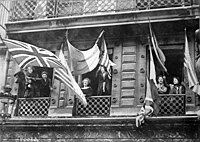| Lëtzebuerger | |
|---|---|
 Map of the Luxembourgish diaspora in the world (includes ancestry and Luxembourger citizens from other countries). Map of the Luxembourgish diaspora in the world (includes ancestry and Luxembourger citizens from other countries).Luxembourg + 10,000 + 1,000 | |
| Total population | |
| c. 300,000 (2013) (Luxembourgish ancestry) | |
| Regions with significant populations | |
(self-identified Luxembourgers) | |
| Languages | |
| Luxembourgish (L1) French • German (L2) | |
| Religion | |
| Predominantly Roman Catholicism | |
Upper estimate is merely a sum of all referenced figures given below. In 2013, 55.5% of the population of Luxembourg (537,039) declared sole Luxembourgish ethnic descent and nationally, while the remaining 45.5% were either of foreign descent or foreign nationals. |
| Part of a series on the |
| Culture of Luxembourg |
|---|
 |
| History |
| People |
| Languages |
| Mythology and folklore |
| Cuisine |
| Festivals |
| Religion |
| Art |
| Literature |
| Music |
| Media |
| Sport |
| Monuments |
| Symbols |
Luxembourgers (/ˈlʌksəmbɜːrɡərz/ LUK-səm-bur-gərz; Luxembourgish: Lëtzebuerger [ˈlətsəbuəjɐ] ) are an ethnic group native to their nation state of Luxembourg, where they make up around half of the population. They share the culture of Luxembourg and speak Luxembourgish, a West Germanic language.
Luxembourgers were, much like Austrians, historically considered to be a regional sub-group of ethnic Germans and viewed themselves as such until the collapse of the German Confederation. Luxembourg became independent, while remaining in personal union with the Netherlands, after the signing of the Treaty of London in 1839. The personal union proved short-lived as it was bilaterally and amicably dissolved in 1890.
Legally, all citizens of the Grand Duchy of Luxembourg are considered to be Luxembourgers per Luxembourgish law, although a distinct Germanic ethnolinguistic identification is vocally espoused and promoted. The corresponding adjective is "Luxembourgish".
Historical background
Most ethnic Luxembourgers live in the Grand Duchy of Luxembourg (Luxembourgish: Lëtzebuerg), a small landlocked country in Western Europe, situated between Germany, France, and Belgium, and are of Celtic/Gallo-Roman and Germanic (Frankish) origin. Luxembourgish is the only native language of Luxembourgers (as taught by parents), although nearly all of them learn French and German in school and are able to communicate in these two languages as well from an early age on. Despite the rather small number of Luxembourgers, there is a relatively large diaspora of their people, both in Europe and elsewhere, most notably overseas in North America. Particularly, there are populations in the surrounding countries of Belgium, France, and Germany. For the most part, this is due to historic reasons, especially the three Partitions of Luxembourg, which led to former territories of Luxembourg being incorporated into each of the three surrounding countries.
As previously mentioned, there are also significant populations of Luxembourgers in the Americas, with the largest contingent being in the United States. Others migrated to the medieval Kingdom of Hungary along with Germans during the first phase of German eastward settlement (German: Ostsiedlung) in the 12th century (and, later on, during the Modern Age). Transylvanian Saxons (in particular) and Banat Swabians (partly) are the descendants of these settlers. Furthermore, the Transylvanian Saxon dialect is very close to Luxembourgish. In addition, the Zipser Germans in the historical region of Zips, Slovakia (but also their descendants in Maramureș and Bukovina) are also part of the Luxembourgish diaspora given the fact that part of their ancestors stemmed from the northwestern Lower Rhineland and adjacent or neighbouring areas.
The explanation for the cultural, ethnic, and linguistic ties between the Saxons in Transylvania and the Luxembourgers is rather simple, namely that the first waves of Transylvanian Saxon settlers who colonised parts of Transylvania, present-day central Romania stemmed from the Rhine-Moselle river valley region and, implicitly, from Luxembourg as well. These settlers were part of the Ostsiedlung colonisation process in Central and Eastern Europe and were invited during the late 12th century, during the High Middle Ages, by the King of Hungary Géza II to develop, fortify, and defend southern and south-eastern Transylvania against invading Asian peoples (e.g. Cumans, Pechenegs, Mongols, or Tatars). Moreover, in 2007, Luxembourg City shared the status of European Capital of Culture with the Romanian town of Sibiu (German: Hermannstadt), one of the most important historical urban centres of the Transylvanian Saxons, both in the past and present, in cultural, administrative, and religious regards as well.
-
 Civil ensign of Luxembourg
Civil ensign of Luxembourg
-
 Luxembourgers celebrating the liberation of their country at the end of World War I in 1918.
Luxembourgers celebrating the liberation of their country at the end of World War I in 1918.
-
 Germans and Luxembourgers in Brazil (1875)
Germans and Luxembourgers in Brazil (1875)
-
 Luxembourg City in 1913
Luxembourg City in 1913
-
 Luxembourgish children (evacuees) in Surrey, England (1942), saying grace before a meal
Luxembourgish children (evacuees) in Surrey, England (1942), saying grace before a meal
-
 The Grand Ducal couple of Luxembourg alongside their children (1971)
The Grand Ducal couple of Luxembourg alongside their children (1971)
See also
- Luxembourgers in Chicago
- Luxembourgish Americans
- Luxembourgish Brazilians
- Luxembourgish-Canadians
- Portuguese Luxembourgers
Citations
- "La progression de la population du Grand-Duché continue: 537 039 résidants au 1er janvier 2013" [The population growth of the Grand Duchy continues: 537,039 residents as of 1 January 2013] (PDF) (in French). Statnews. April 18, 2013.
- Levinson, Amanda. "The Regularisation of Unauthorised Migrants: Literature Survey and Country Case Studies – Regularisation programmes in Luxembourg" (PDF). Centre on Migration, Policy and Society, University of Oxford. Archived from the original (PDF) on 2 September 2006. Retrieved 2 September 2006.
- "Loi du 24 février 1984 sur le régime des langues. - Legilux".
- "Discrimination in the EU in 2012 – Special Eurobarometer 393 (The question asked was "Do you consider yourself to be...?")" (PDF). European Commission. Archived from the original (PDF) on 2 December 2012. Retrieved 2 February 2016.
- Cole (2011), p. 246
- Luxemburgisch, Luxembourgish at Oxford English Dictionary; Luxembourgeois at Oxford English Dictionary
- "List of countries, territories and currencies". Interinstitutional Style Guide. Publications Office of the European Union. 2012-01-24. Archived from the original on 2012-02-05. Retrieved October 19, 2017.
- Victor Rouă (14 November 2015). "The Transylvanian Saxon Citadel Of Reps (Rupea)". The Dockyards. Retrieved 16 January 2023.
- Vu(m) Nathalie Lodhi (13 January 2020). "The Transylvanian Saxon dialect, a not-so-distant cousin of Luxembourgish". RTL. Retrieved 18 September 2022.
- Stephen McGrath (10 September 2019). "The Saxons first arrived in Romania's Transylvania region in the 12th Century, but over the past few decades the community has all but vanished from the region". BBC Travel. Retrieved 18 September 2022.
- Victor Rouă (19 August 2015). "A Brief History Of The Transylvanian Saxon Dialect". The Dockyards. Retrieved 16 January 2023.
- James M. Beidler (7 July 2022). "Researching the "Germans Outside Germany" in Eastern Europe". Family Tree Magazine. Retrieved 24 April 2023.
- Victor Rouă (3 October 2015). "The History Of The Transylvanian Saxons". The Dockyards. Retrieved 16 January 2023.
General and cited references
- Cole, Jeffrey (2011). Ethnic Groups of Europe: An Encyclopedia. ABC-CLIO. ISBN 978-1598843026.
- Minahan, James (2000). One Europe, Many Nations: A Historical Dictionary of European National Groups. Greenwood Publishing Group. ISBN 0313309841. Retrieved 25 May 2013.